
SO comprehensive was the Golf Mk7’s victory in the 2013 edition of Wheels Car of the Year, that there were many mutterers in the office who believed that were it eligible for entry the following year, it would have wiped the floor with the best of 2014’s crop.
While this would have denied thousands of online commentators the chance to congratulate us on our choice of the BMW i3 for COTY 2014, the extravagantly talented Golf 7 has remained the benchmark car in its class, before being mildly refreshed this year in 7.5 guise.
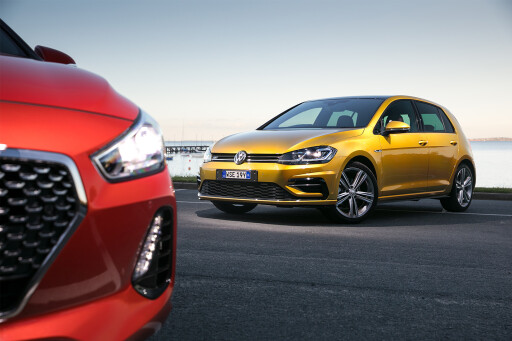
We’re used to there being barely a chink in the Golf’s armour, but examine the refreshed range and you’ll wonder why there’s such a gaping hole between the 110kW 1.4-litre TSI and the forthcoming 169kW 2.0-litre GTI. So in order to take the box-fresh Golf out of its comfort zone, we’re pitching the 1.4-litre TSI against a trio of talented rivals that ask much the same price that Volkswagen charges but pack significantly more herbs.
Holden’s Astra, a Wheels Car of the Year 2017 contender, needs little in the way of introduction. We’re unashamed advocates of the Opel-bred hatch’s dynamics and the 147kW 1.6-litre turbo RS-V range-topper is, by a margin, the cheapest car here.
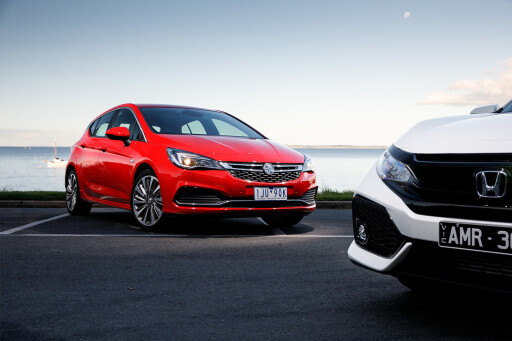
Blue-tinged of collar it may be, but waging asymmetric warfare against the occasionally haughty Volkswagen could well prove Holden’s masterstroke.
On paper, the Hyundai i30 SR Premium appears an instant front-runner. With a huge equipment list, a peppy 150kW from its 1.6-litre turbo four, an independent rear end at last, and a newfound confidence in third-gen guise, the i30 has nothing of the underdog about it. Back that up with a five-year warranty and the Korean comes in swinging.
Honda’s Civic hatch has divided opinion with its styling, but there aren’t too many dissenting voices on the quality of its chassis or the sheer amount of car on offer, the Civic looking almost half a class bigger than the norm. With 127kW under the bonnet from its 1.5-litre turbo four, driving through a CVT gearbox, is the Honda a little too big for its own good?

Running numbers on the cars was instructive, but first a mea culpa. In the bleary-eyed pre-dawn, we fuelled the Golf with the minimum-recommended 95 rather than 98 RON as was used in the others, in the process exacerbating its already hefty power deficit. So it was perhaps no great surprise that it logged the slowest times at the strip, recording 8.3 seconds to 100km/h and a 0-400m time of 16.2 seconds.
Still, that’s a mere tenth down on Volkswagen’s claimed numbers which, given the car was loaded to the gunwales with options and was asked to perform on a cold and damp track, was a hugely creditable showing. Exciting, no, the dual-clutch transmission registering not one chirrup of wheelspin, but impressive in its own way.

The Civic and Hyundai were predictably quicker, but the champ in a straight line was the Astra, the Vbox churning out 7.2 seconds to 100km/h and 15.2 seconds to 400m. Round one to Holden, then, despite the fact the Astra’s familiar silhouette and slight dearth of charisma meant that it was always the last set of keys left in the hat. Even in RS-V specification, the car’s fussy wheels and equally over-elaborate three-quarter detailing undersell what’s on offer.
At just $31,740 for this automatic model, the RS-V delivers serious value for money, offering almost $2000 worth of headroom to the next most expensive car in this test, the $33,590 Honda Civic VTi-LX. The Astra’s hardly in stripper spec either, with LED front and rear lights, heated seats and steering wheel, and a whole suite of electronic safety functions like AEB, lane-keep assist, adaptive cruise, and blind-spot alert.
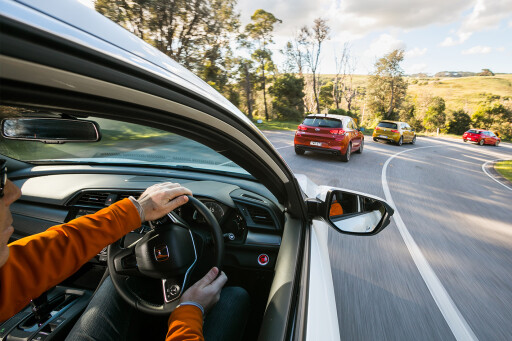
Spring for the Civic and you do get a lot of styling. All of it in fact. In a swage-line-per-dollar comparison, the Honda registers a solid six stars out of five. Beyond that, the lane keep/adaptive cruise combination is the best calibrated of the lot here, giving the car a taste of the old-school meticulous Honda engineering many thought had gone for good. The mapping graphics, on the other hand, look as if the designers had run riot with a jumbo pack of fluoro markers.
The i30 would seem to wear its $33,950 sticker price a little self-consciously, but the range-topping SR Premium with the auto ’box packs a lot in. Strip it back to the SR with a manual box (with the added bonus of a manual handbrake too), and that would run you a mere $25,950. Would you really miss the LED headlights, a panoramic glass sunroof, heated and cooled front seats, chrome body finishes, one-touch windows, and a power outlet in the luggage area?

It’s still absolutely rammed with kit including the phone charging induction pad (iPhone users need to buy a special case to power up their handsets). That said, the auto model also bundles in AEB, adaptive cruise, and lane-keep assist, which goes some way to justifying the price.
The Golf should retail at $34,490 in Highline trim, but somebody got a bit keen when specifying this test car and added the driver assistance package, infotainment package, R-Line package, and some wholly outre Turmeric Yellow metallic paint to bump its price up to within $50 of an outgoing GTI. Try to ignore the tinsel; the car doesn’t need it.
The added 18kW over the old 92TSI doesn’t make as much difference as expected. There’s an extra 50Nm of torque on tap when the turbocharger gets its trousers on from 1500rpm, but the Golf 7’s character and its winning combo of pliant ride and perky handling carry over much as before. Volkswagen claims to have digitised the Golf with this midlife makeover, and with the 12.3-inch Active Info Display in the cowl, you can render yourself digitally surprised and delighted, though the standard Highline doesn’t get this, so it’s as you were.

Tailing the Golf through a set of hairpins in the i30 is instructive. There’s a benign malleability to the way the Hyundai tackles a road. It’s soft-edged, with long strokes to the pedal arcs and a one-pause-two as the body settles into a corner, but it’s certainly quick across country. The steering and gearbox are bang on the money for a warm hatch, responsive but never neurotic. Driven up to about eight-tenths, the i30 is a heck of a package, with only an initial lack of brake pedal response counting against it.
Turn the wick up further and it’s clear where Volkswagen spent all that budget on the Golf 7. The Hyundai’s composure deteriorates, the steering rack rattling, the ESP system chopping in unnecessarily, and the Hankook Ventus tyres lacking the smooth transition into understeer of the Volkswagen’s Bridgestone Potenza rubber. Rev hang is also evident, the engine having a notably lazy spool-down.
The Civic also struggles when given a stern examination, but the problem here isn’t the chassis. It’s the CVT, which, even in Sport mode, never puts enough torque on the table as you engage the front of the car into a corner. It feels akin to entering in neutral and taking up the clutch in a manual car, the 1.5-litre turbo lump delivering enough Newton metres to drag the car into some semblance of composure two-thirds of the way through a bend after a clumsy pass at the apex.
Marshal the ’box yourself via the wheel-mounted paddles and the engine sounds thrashy as you try to make the most of the meagre 220Nm. It’s all a bit of a shame, as the Civic clearly features a talented chassis, but it’s been comprehensively hobbled by the unhappy engine and gearbox combination.
The Astra RS-V has no such issue. It’ll drive clean away from the Golf on any road you care to choose, courtesy of handling that’s at least on par and a manifestly superior powerplant. The Golf’s 1.4-litre TSI unit sounds hollow and somewhat two-dimensional when absolutely wrung out in pursuit of the Holden, feeling all of its 37kW and 50Nm deficit.
In fact, the Astra just gets better the more abuse you fling at it, signalling the edge of adhesion by a rapid-fire drumming harmonic from the outside front suspension assembly. One suspects you’d find its shortcomings on track, but for a fast road setup, the dynamics represent a sweet set of compromises. Even the Sport mode does a decent job, weighting up the steering by a few degrees without introducing a synthetic stickiness. Hats off to the chassis teams at Russelsheim and Lang Lang. It’s a heck of an achievement.

It’s well packaged too, with what feels like the most passenger space in the back, although beyond that it’s a bit mean. There’s no centre armrest, no door grab handles, no rear cup holders, no rear air vents, and a door armrest that seems to have been designed to cater better for baby T. rexes than Homo sapiens.
Aside from the glitzy piano black and chrome detailing, there are some notable downsides to the fascia design.
The phone holder’s a waste of space, it’s the only car here with no shift paddles, and the door mirrors are set too far back, requiring a turn of the head rather than a flick of the eyeballs. The massive AEB intervention light atop the dash reflects in the windscreen and the starter button is hidden around the back of the wheel where the driver’s watch clasp will inevitably rake the leather rim. And the warning chimes are enough to send you postal.
It’s these sorts of errors that Volkswagen tends not to make. The Golf’s cabin feels smart and cohesive, and about the only minor ergonomic complaints are a poorly sited idle-stop kill switch, a fiddly USB input, and a central screen that has a slight look of the aftermarket about it when it powers down. Other than that it’s all expensive touch points, considered sight lines out of the car and silicone-damped feel-good slickness. Accommodation in the rear is good, although passengers won’t be able to get their feet under the electrically adjustable front seats if they’re set low.

The i30’s cabin looks clean and fresh, with red anodised-look detailing on the wheel, vent bezels, and air con controls that could have looked really cheesy but instead is just about subtle enough. The rear is the tightest of the bunch with a firm seat cushion, but that aside, it’s a class act. The ride quality is the best here too, the damping being initially soft in its travel and then firming up rapidly. Visibility out of the car is extremely good and the mirror placement is excellent, but the electric seat ought to drop a bit lower for a car with sporting aspirations.
No such issues for the Civic. It feels as if your rear end is skimming a few millimetres above the bitumen. It’s wide inside, with at least as much rear legroom as the Astra and a little more than the Golf. The chunky camera that sits on the passenger door mirror is a good idea in concept, but it’s often distracting when its image flicks up on the central display.
Yet it’s probably a good thing as the rear three-quarter visibility on the Civic is scandalous. There are, however, some thoughtful design touches evident in the execution of the Civic’s packaging. The fabric parcel shelf roller blind is one, and the way the global closure on the key also shuts the sunroof is another. The HDMI port located in the nether regions of the fascia will be a head scratcher for some, but it’s used for smartphone mirroring via HondaLink apps.

Sorting these cars into some semblance of order is surprisingly easy. The Honda is the only car here with a glaring shortcoming. No, it’s not the styling. The CVT gearbox does it no favours whatsoever and masks what is a dynamically capable car. Add a decent auto and a lick more power and the Civic would be on the money or thereabouts. There’s work to be done here for the next refresh.
The Hyundai initially looked as if it would give the Golf a stern test and, in many regards, it fits the warm hatch brief best. Our money would go on a manual SR, a car that would have posed us a few more searching questions than this full-fruit auto SR Premium version, but the i30 has earned its spurs in some tough company.
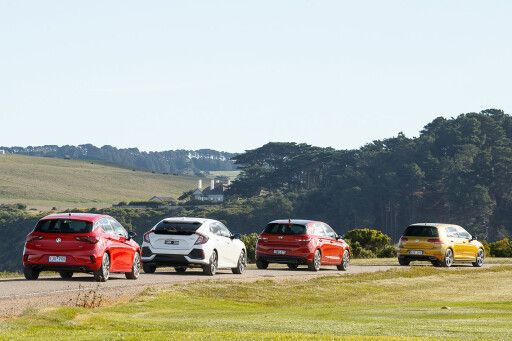
The Astra came close. Initially unfancied in comparison to the more overt charms of the Golf and the i30, the RS-V inveigled its way into our affections the longer we drove it. It has a number of annoying detail glitches that ought to have been fixed early in the design process but the fundamentals are just so robust. The Holden feels bulletproof, Australia-proof even, in a way that none of the others, not even the imperious Volkswagen, can quite pull off. For that, it earns the runner-up spot.
It can’t topple the Golf, though, and, truth be told, it wouldn’t have bested Golf 7, let alone iteration 7.5. As a tester, you’re constantly asking whether you’re being gulled by Volkswagen’s polish, seduced by a superficial sheen of glitz, but no. There’s real substance to the Golf, showing the more powerful Hyundai and Honda a clean pair of heels on a challenging road and offering the cleanest ergonomics, the most mature design ethos, the sweetest consistency of control weights and, in almost every area, a greater depth of engineering.
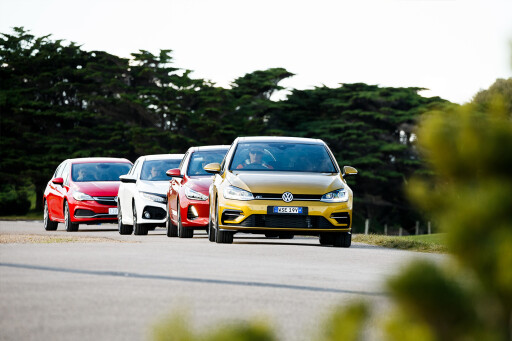
If Porsche built a hatch, it would probably feel a lot like the Golf 7.5.
That’s the result of years of continuity in the car’s development; Volkswagen’s nuanced understanding of what works and what doesn’t. Maybe Hyundai will develop that. Holden and Honda certainly haven’t, successive generations of Astra and Civic succumbing to a sort of developmental amnesia where the best aspects of predecessor models are inexplicably jettisoned in favour of a different look and feel.
Volkswagen doesn’t attempt to reinvent the wheel with each generation of Golf. It just makes it incrementally better. And that’s why it wins.
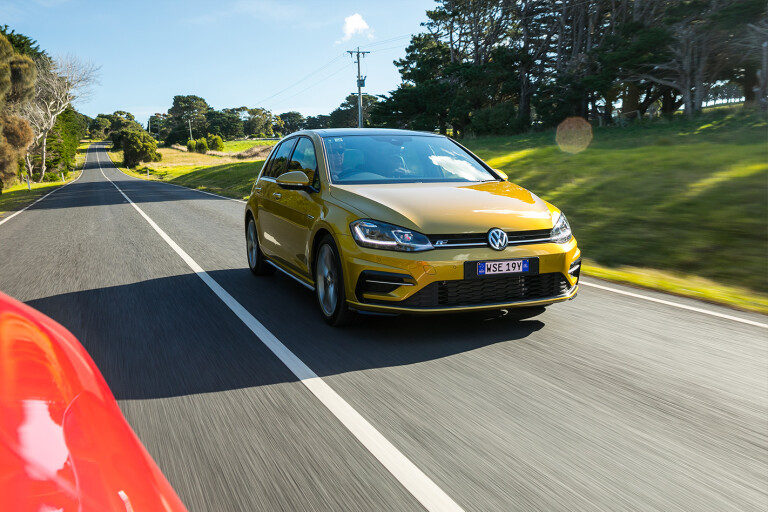




COMMENTS